by 24fit | Jul 23, 2015 | Body Composition, Nutrition, Strength Training, Wellness Coaching
If you’re Level 10 goal includes trying to lose weight, the good news is that muscle burns more calories than fat, so maintaining muscle can be a big help in reaching your goal. To do this you need to combine regular exercise including strength training with balanced nutrition including adequate amounts of high quality protein. This post also covers why working out, without the right nutrition can be counterproductive.
Do you know how much protein you should be eating?
The amount of protein you need to eat every day depends on a lot of factors like how much you weigh, and how much muscle you have – not just whether you’re male or female.
Does a ‘one size fits all’ for protein make sense? Calorie needs differ from person to person, so why not protein? After all, people come in all different sizes, and their body composition is highly variable – it stands to reason that protein needs could vary a lot, too. It doesn’t seem right that a 220lb (100kg) guy who works construction and is into working out would have the same protein needs as a 150lb (68kg), male bank teller who sits most of the day and spends his evenings on the couch.
How much protein is right for you?
Since protein is so important in maintaining your lean body mass (basically, everything in your body that isn’t fat), the suggested amount of protein you should eat every day depends, in part, on how much lean mass you have. Ideally, you’d get a body composition measurement done which would tell you how much lean body mass you have. Contact us to find out how much lean muscle you have,
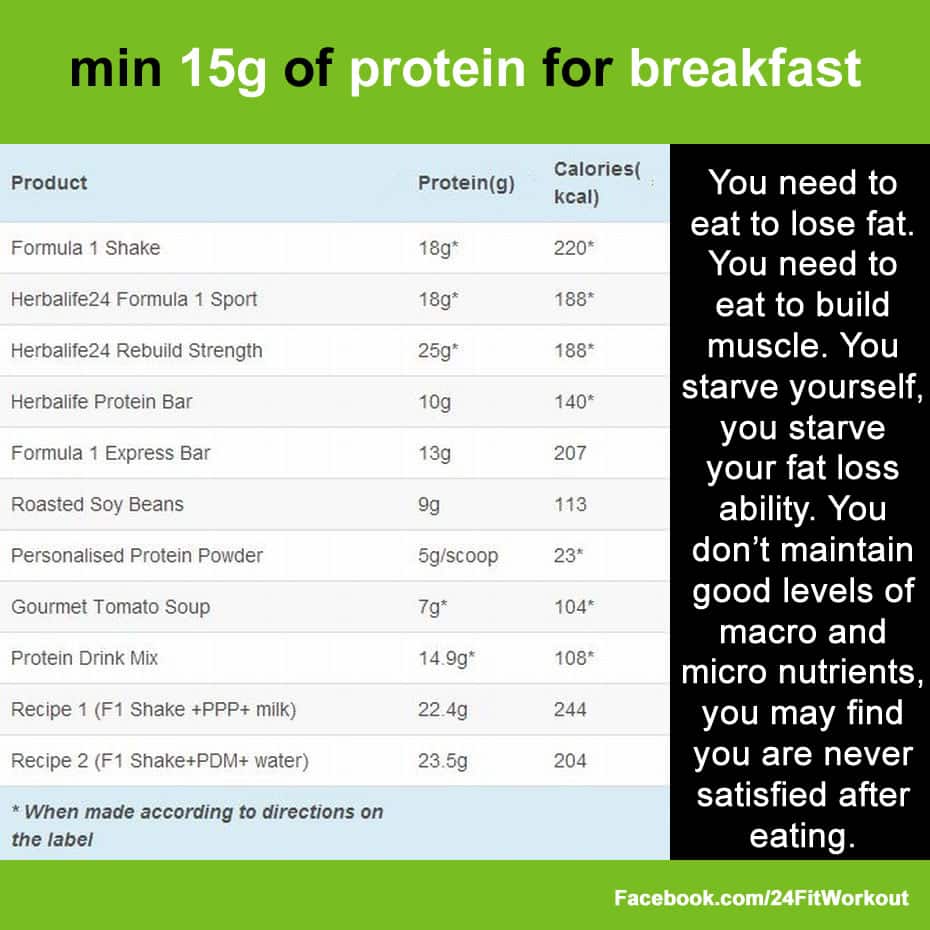
When is the best time to eat protein?
A common mistake is to consume the majority of protein intake at one meal often in the evening. Protein should be included at all mealtimes for maximum muscle health. and particularly after resistance and strength training because this is when the body is most receptive to using protein to build muscle.
According to research: from a team of scientists led by muscle metabolism expert Doug Paddon-Jones of the University of Texas Medical Branch at Galveston. This research shows that the typical cereal or carbohydrate-dominated breakfast, a sandwich or salad at lunch and overly large serving of meat/protein for dinner may not provide the best metabolic environment to promote healthy aging and maintenance of muscle size and strength.
Amount of protein in typical foods?
Here are some examples
Example: Chicken Breast 3oz (85g), cooked weight 25g
Lean Red Meat 3oz (85g), cooked weight 25g
Ocean-Caught Fish 4oz (100g), cooked weight 25-30g
Yogurt, Greek Style, nonfat 4oz (100g) 10g
Why working out, without the right nutrition can be counterproductive?
You workout 5-6 days a week, and despite your herculean workout regime and monastic eating habits, you can’t seem to lose a pound. In fact, your body fat percentage is inexplicably increasing. Your toned arms seem softer and your jeans feel just a bit snugger than they did last month.
Our body needs energy for strength training, cardio, walking, sleeping, digestion, etc. This energy comes from food. The calories in food are fuel for your body. If you don’t supply the right fuel including protein then you will suffer from the following:
– Strength Loss. Your body doesn’t receive the energy it needs for the physical activities you do. You’ll feel tired and weak at the gym.
– Fat Gains. Fat is emergency storage for your body. Your body burns muscle for energy first when you don’t eat. You’ll become skinny but fat.
– Muscle Loss. The weight loss is muscle loss. Muscle loss equals fat gains as muscle burns more calories than fat.
What are the best sources of protein?
Protein is found a wide variety of foods including dairy products, eggs, meat, fish, pulses and nuts. Some of these protein rich foods contain all the essential amino acids are considered high quality protein, while other sources can be lacking in some of these essential amino acids.
Source of high-quality protein include dairy products, eggs, meat, fish and soy protein isolate. Eating a wide variety of protein-rich containing foods helps to ensure we get all the amino acids we need.
Healthy meal replacements such as Formula 1 and post workout shake such as Rebuild Strength contain high quality protein. Easy and convenient, these are particularly useful before or after training and time is tight and when you do not have time to prepare and eat a meal. Shakes typically contain between 18-25g of protein.
Post Workout
A Herbalife shake after training accelerates lean muscle growth, which in turn revs your metabolism and burns more fat, and speeds up recovery. Eating soon after your workout also can prevent you from feeling deeply ravenous and overeating later on. If you don’t get enough protein, your muscles aren’t able to repair themselves after a workout. In such a case, strenuous exercise can actually be counterproductive—you aren’t able to rebuild what you tear down, and you actually become less able to burn calories.
Wellness Coaching
Contact us for a personalised protein prescription based on how much lean muscle mass you have. And for details of your resting and active metabolic rates which impact how many calories you should take. To lose weight you need to create a deficit in calories from your active metabolic rates BUT WITHOUT LOSING LEAN MUSCLE; otherwise you will be in worse situation than when you started!
Additional Information:
Snacking on Protein rich snacks
Balanced Nutrition
by 24fit | Jan 2, 2015 | Body Composition, Fat Burning, Metabolic Analysis, Nutrition, Periodization Training, Strength Training, Wellness Coaching
Happy New Year! Wishing all users of the 24Fit Workout a Happy and Healthy 2015. Good luck with all of your fitness goals!
Here are some tips for losing body fat in the New Year:
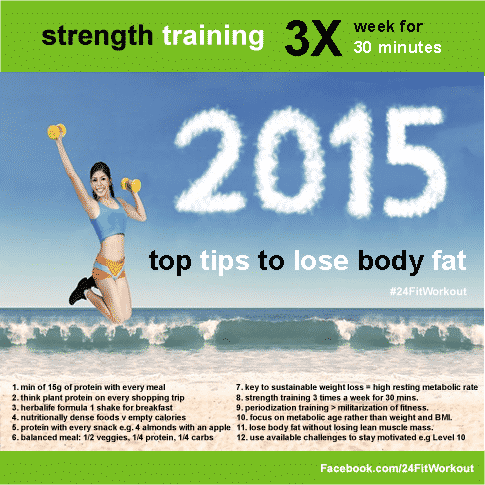
Nutrition
1. Min 15g of protein with every meal, personalised to the individual. For example, a male who is 5ft 10″ requires more protein than a female at 5 ft. 4″. Contact us for a protein prescription.
2. Think plant protein on every shopping trip e.g. Quinoa/Almonds. Plant Protein is low in saturated fat, alkaline-forming and easy to digest.
3. Choose Formula 1 Shake for breakfast, a healthy and tasty form of plant protein and also contains complex carbs fibre and nutrients.
4. Focus on balanced nutrition, replace high fat, high calorie, high sugar, low nutrition foods with nutritionally dense foods such as the Formula 1 Nutritional Shake Mix and meal bars. If you don’t maintain good levels of macro and micro nutrients, you may find you are never satisfied after eating, or still lack energy, making you reach for products such as sugary drinks, biscuits or other unhealthy snacks. These foods can cause an energy spike (rise in blood sugar) followed by an energy crash (fall in blood sugar), which leads to further fatigue and hunger. vitamins and minerals play a key role in cell function converting macronutrients into energy. It’s not just about counting calories it’s about balanced nutrition.
5. Skip the empty calories of starchy or sugary food. Avoid processed carbs. They prevent use of fats, spike insulin, and cause inflammation. Don’t eat carbs alone.
6. Find alternative to carb based snacks with those sugar highs and lows. Choose from fruit, protein and vegetable snacks. Eat protein with every snack e.g. 4 almonds with an apple
7. Ideal proportions for balanced main meal? 1/2 vegetable/salad, 1/4 protein, 1/4 carbs
8. 24Fit Nutrition Philosophy: 30% fats, 40% carbs, 30% protein from both foods and supplements
9. Take a break after each course. It takes about 20 minutes for your stomach to communicate to your brain that it has had enough. You’ll enjoy more, and eat less.
10. Focus on low GI foods, by virtue of their slow digestion and absorption, produce gradual rises in blood sugar and insulin levels.
11. Use the Herbalife meal replacement programme to reduce your calorie intake say 250-500 calories less than your active metabolic rate. And calorie intake personalised to body composition, gender and activity. To lose weight you need to create a deficit in calories from your active metabolic rate. However, WITHOUT LOSING LEAN MUSCLE. There here are 101 ways to reduce your calorie intake, but many restricted diets may lead to losing muscle. Reduce calories whilst getting many more nutrients than everyday foods ( protein, fibre, vitamins & minerals, complex carbs), the science of meal replacement. Feed the body so its gets everything it needs, its fully nourished, that’s not a low calorie cereal for breakfast and low calorie soup for lunch! Exercise on a restricted diet, can be counterproductive as you lose muscle rather than gain it..
12. The key to sustainable weight loss (as opposed to the “yoyo” weight loss and weight gain of trendy weight loss fads) is a high resting metabolic rate as well as balanced nutrition. Your resting metabolic rate, or the calories you burn throughout every minute of the day, is much more important for weight management than the calories you burn while exercising. One pound of muscle burns about 15 calories, one pound of fat burns 3 calories.
13. Strength training 3 times a week for 30 mins (at gym with equipment, a class with weights, fit camp with own body weight, at home with resistance bands/dumbbells with the 24Fit Workout)
14. Take part in your favourite cardio exercise (dancing, walking, running etc.)
15. Over 35? Step up your strength training. By your mid-30s, most people still look young, but are already experiencing the BIG Three of aging: deteriorating lean muscle mass, worsening posture, and crumbling joints.
16. Choose “Periodization Training” (24 Fit Workout) over the “Militarization of Fitness“. Teach your body to burn body fat over time rather than just burn carbs.
17. Use a post workout shake after training which accelerates lean muscle growth, which in turn revs your metabolism and burns more fat, and speeds up recovery. Eating soon after your workout not only speeds the recovery process, it also can prevent you from feeling deeply ravenous and overeating later on. Recovery shake = 10-20 of protein.
Metabolic Analysis
18. Focus on metabolic age and resting metabolic rate rather than weight and BMI. Metabolic age can give you greater insight into your health habits. A metabolic age that is substantially lower than your chronological age means, compared to the average person in your age group, you have more muscle mass, less fat, are probably more active, and therefore can consume more calories.
19. Metabolic testing unlocks the secrets held in the individual physiology of each of our clients and is crucial to our success in helping people of all ages and abilities reach peak fitness and optimum body weight. Many clients come to us in frustration because they have reduced their calorie intake and increased their training, but are still unable to achieve the body they desire. At this point, they are consuming fewer calories than their body needs for basic systems function, forcing their metabolism to slow to an idle to conserve every calorie consumed. The result is a sluggish metabolism that stores fat instead of burning it for energy. With the information gleaned from this test, we can accurately prescribe for you the quantity of calories you need in order to keep your metabolism revving all day long. The result is less body fat and more energy.
Challenges
20. Pick a Spring Event Goal: Having a specific event to train for like a 5K or a charity bike ride will give you purpose and added motivation to train through the difficult winter months.
21. Utilise Herbalife Challenges: Level 10 Body Transformation Challenge, 5k in 5 weeks, Weight Loss (biggest loser challenge), and 24 Fit Challenge. It takes 90 days to change eating and exercise habits so use the 90 day challenges to help you with motivation.
Education, advice and support
22. Use Wellness Coaching with 24Fit to transition from where you are to where you would like to be: 1.Nutrition 2.Exercise 3.Metabolic Analysis. 4.Challenges, 5. Education, advice and support.
23. Use Herbalife programmes to establish a healthy pattern for yourself a structured eating routine – say, a Formula 1 shake in the morning, a piece of fruit mid-morning, a salad or veggies with protein for lunch(or another shake or meal bar), a protein snack in the afternoon, and a well-balanced dinner. Programmes available:
“Get Lean and Fit”
“Get Ripped”
“Performance Nutrition”
In summary, balanced nutrition, a healthy active lifestyle, tracking results, challenges and a personalised programme to get results. Message us for advice.
by 24fit | Oct 30, 2014 | Body Composition, Metabolic Analysis
If you want your workouts to be 100% productive, and your nutrition tailored to your personal physiology, then all your health and fitness efforts should begin with metabolic analysis. Metabolic testing unlocks the secrets held in the individual physiology of each of our clients and is crucial to our success in helping people of all ages and abilities reach peak fitness and optimum body weight. This testing will allow us to help you too, because it allows us to accurately determine a key aspect of your physiology when it comes to achieving and maintaining good health and high levels of fitness, that is the exact number of calories you need daily in order to maintain, increase, or decrease your body weight.
Without this testing, all other exercise and nutrition programs are based on a guess when it comes to the calories you require each day to reach your goals.
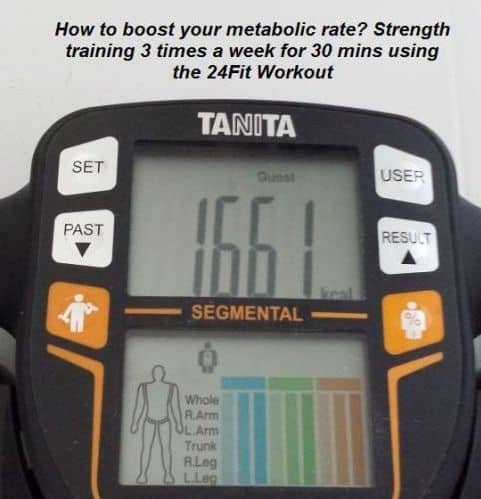 Resting Metabolic Rate Test
Resting Metabolic Rate Test
The key to sustainable weight loss (as opposed to the “yoyo” weight loss and weight gain of trendy weight loss fads) is a high resting metabolic rate. Your resting metabolic rate, or the calories you burn throughout every minute of the day, is much more important for weight management than the calories you burn while exercising. The term “metabolic refers” to how your body makes energy. Your resting metabolic rate is the rate at which your body burns calories to run your bodily functions at rest.
Many clients come to us in frustration because they have reduced their calorie intake and increased their training, but are still unable to achieve the body they desire. At this point, they are consuming fewer calories than their body needs for basic systems function, forcing their metabolism to slow to an idle to conserve every calorie consumed. The result is a sluggish metabolism that stores fat instead of burning it for energy.
With the information gleaned from this test, we can accurately prescribe for you the quantity of calories you need in order to keep your metabolism revving all day long. And the right amount of protein to help build lean muscle. The result is less body fat and more energy.
Whats about Active Metabolic Rate
Take your RMR and use a multiplier based on your activity level. To lose weight, consume 250-500 fewer calories than your active metabolic rate, using the Herbalife Meal Replacement Programme. The aim is lose weight and body fat but without losing lean muscle. Ideally increasing your lean muscle so you can burn more calories every day
Do include a strength training element into your programme, that is 3 times a week for 30 minutes using the 24Fit DVD’s. Do include a recovery shake such as Rebuild Strength. Don’t skip your protein shake after you exercise and think that you’ll save calories! A protein shake after training accelerates lean muscle growth, which in turn revs your metabolism and burns more fat, and speeds up recovery. It also can prevent you from feeling deeply ravenous and overeating later on. Exercise and nutrition working together to get the best results. Thats #24fit.
Contact us for advice: options for metabolic testing, protein factor, resting and active metabolic rates.
by 24fit | Sep 10, 2013 | Body Composition, Fat Burning, Over 35s, Strength Training
Many people put on weight as they get older – but it doesn’t have to happen. Let’s talk about why weight tends to creep up with age, and what can you do about it.
I can’t tell you how many times I’ve had a patient say to me, “everybody gains a little weight as they get older!” To them, picking up a few extra pounds every year is just something to be expected. And, they figure, if “everyone is doing it” – it must be okay. But truth is, middle-aged weight gain doesn’t happen to everyone. Yes, some adults put on weight fairly steadily in their middle years – to the tune of about a pound a year, on average. But just because creeping weight gain does happen to a lot of people, doesn’t mean that it has to.
Why do we tend to put on weight as we age?
It may seem that weight gain as you get older is inevitable – but it’s not. That’s not to say you don’t need to pay attention though – you’ve still got plenty of things working against you that can make weight management more challenging with each passing decade.
For one thing, there’s often a downward shift in the number of calories you spend when you exercise. As you get older, you may tend to move a bit less, or to exercise less vigorously – all of which adds up to fewer calories burned over the course of the day. If you’re exercising less than you used to – but still eating the way you did in your 20’s – you shouldn’t be surprised if you’re packing on the pounds.
Then there are changes in body composition that are a natural part of the aging process. You tend to lose muscle as you age – partly because your muscle cells just don’t repair themselves the way they used to. When you’re younger, the everyday wear and tear of your muscles gets patched up relatively quickly, but over time, the process slows down – which means you can lose some muscle mass. Natural dips in hormone production – estrogen, testosterone and growth hormone levels all decline with age – can also contribute to some loss of muscle mass.
Since muscle tissue does a lot of metabolic ‘work’ that uses up a lot of calories, the loss of muscle tissue as you age means that you will burn fewer calories per day than you used to – in other words, your metabolic rate slows down.
This subtle shift in your metabolism starts somewhere in your 20s or 30s. You start to slowly lose muscle tissue and gradually pick up some body fat. By the time women reach the age of about 40 and men enter their 60’s, they start to lose about 6-8% of their muscle mass every ten years. That translates into a drop in metabolic rate of about 10% every decade.
Diet clearly plays a role here, too. If the rate at which you burn calories is slowing down, then you need to apply the brakes to your calorie intake, too, if you want to avoid weight gain. In many cases, people are taking in too many calories simply because they are eating they way they did 20 years ago, but moving a lot less. But the other thing that sometimes happens as people get older is that their eating habits change – and not always in a good way. “Empty nesters” who are no longer cooking for a family might stop preparing full, healthy meals. Instead, they might snack more, or rely more on higher calorie convenience foods or fast foods. Some people simply eat more meals out because it’s easier – but calorie control is often sacrificed. And, as people get older and find themselves less busy, eating can also become a calorie-laden form of entertainment.
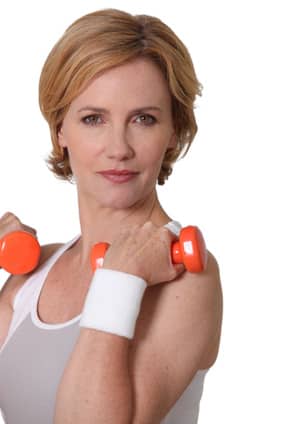 6 tips for controlling your weight as you age
6 tips for controlling your weight as you age
- Don’t assume that weight gain is inevitable. With that attitude, you’ll be a lot less likely to take the necessary steps to keep your weight in check. Gaining weight in your middle years doesn’t ‘have to’ happen – and if it already has, it isn’t too late to get it under control.
- Strength train a few times a week. Strength training is one of the best things you can do to retain – and even build – muscle. Since muscle cells burn calories at a much faster rate than fat cells do, building up your muscle mass will boost your metabolic rate. And don’t think you’re too old – studies show that with the proper resistance exercise, even people in their 80s can experience increases in muscle size and strength.
- Keep up with the cardio and you could keep weight gain in check. Any exercise that gets your heart pumping is going to burn calories, so aim for at least 30 minutes of cardiovascular exercise most days of the week. If the pace at which you walk or jog has slowed over time, keep in mind that you’ll also be burning fewer calories than you used to. To compensate, you’ll need to cut your calorie intake a bit or – if you can – exercise for a little longer. If you haven’t exercised in a while, be sure to get clearance from your doctor before you start out.
- Fill up on low calorie, high-volume foods. Vegetables and whole fruits are “nutrient-dense” – which means they offer up a lot of nutrition for a relatively small calorie cost. Vegetables and whole fruits not only provide a lot of nutrients, they contain plenty of water and fiber, so they help to fill you up – not out.
- Eat protein at each meal or snack. Protein not only helps your body to build and repair muscle mass, it also helps control hunger. The trick is to opt for the leanest sources, so that you get your protein without a lot of added fat that can often tag along. Choose seafood, poultry breast, egg whites, low fat or nonfat dairy products, lean cuts of red meat, and plant proteins such as tofu, beans, lentils, and protein powders which can be made into smoothies.
- Keep a diary. A daily journal can help you to stay motivated. Keep tabs on your weight and write down what you eat, how much exercise you do and how much water you drink every day. That way, you’ll be able to track the results and rewards of your efforts.
Written by Susan Bowerman, MS, RD, CSSD. Susan is a paid consultant for Herbalife. Herbalife markets protein-based meal replacements, powders, and snacks.
by 24fit | Apr 5, 2013 | 24 Fit Challenge, Body Composition, Fat Burning, Motivation, Strength Training
Whether you’ve been on a nutrition or fitness program, at some point you’ll hit a plateau where it seems efforts don’t equal results.
A weight loss plateau can zap your motivation, but understanding the reasons behind it can help you meet your goals. According to Susan Bowerman, MS, RD, CSSD, “When you cut back on your calories, your body reacts as if there’s no more food coming its way. So it does what it’s programmed to do — it hangs onto stored up calories by slowing down the rate at which you burn them.”
Further, as your weight drops, your metabolic rate naturally goes down a bit, too. “That means as you lose weight, your calorie needs also drop somewhat. So, to keep losing at the same rate, you need to either cut your intake further, or exercise more — or accept that your rate of weight loss will be slower as you approach your goal.”
From an exercise perspective, you may be pushing yourself harder and harder but the results seem to be slowing. “Pushing your body to the point of exhaustion can spell disaster for your fitness goals. You’ve got to build in time for your body to recharge,” states former Olympian Samantha Clayton, Herbalife’s director, worldwide fitness education. “Then when you start training again, you’ve got a renewed energy and focus.”
Here are eight tips to move off the weight plateau:
• Use a food diary to keep track of your calorie intake – You may have been more careful when you started your diet — weighing and measuring everything that passed your lips — but you might not be as accurate as you once were. This will get you back on track.
• Replace two meals a day with a protein shake to help you stay within your calorie limit. When you make your shake, you know exactly what goes into it — and how many calories are in the protein powder, the milk and the fruit — so it takes the guesswork out of calorie counting. Use the shake for two meals a day, have a healthy third meal, and fill in with snacks of low fat protein foods, veggies and fruits.
• Dine out less often – No matter how careful you think you are when you go to a restaurant, it’s usually difficult to accurately estimate how many calories you’re eating, because it’s often hard to tell exactly how foods are prepared.
 • Step up your activity, particularly strength training – If you’ve been working out for a while and haven’t increased the intensity of your activity, you might not be burning as many calories as you used to. Add some new moves to your exercise routine, increase the intensity, and pump some iron.
• Step up your activity, particularly strength training – If you’ve been working out for a while and haven’t increased the intensity of your activity, you might not be burning as many calories as you used to. Add some new moves to your exercise routine, increase the intensity, and pump some iron.
• You might actually be at the right weight – If you can, get your body composition checked. Muscle is ‘denser’ and takes up less space than body fat — so if you are carrying more muscle than the average person, you might weigh more than you think you should. If your body fat is within normal range, then you may not have much — if any — additional weight to lose.
• Avoid fatigue – Your body needs to re-generate, restore and repair itself often. Your pain receptors will make movements uncomfortable and your joints can become tender when you push your body too hard. The nervous system also needs time to rest in order to adapt and improve from training.
• Follow your natural cycle – Athletes train in cycles for a reason, the timing of training may vary from athlete to athlete but one common factor in every athlete’s training program are pre-planned rest days. A well-rested body will get better results than a tired one.
• Spark excitement – If you are putting your body through the motions day after day, you can become complacent and your exercise intensity is likely to drop without you even realizing. Taking a day or two off from your current workout routine can make you come back to the gym with a renewed commitment and excited approach.
Bowerman is a paid consultant for Herbalife.
by 24fit | Jan 18, 2013 | Body Composition
Its not the weight you are that’s important its what the weight is made up of!
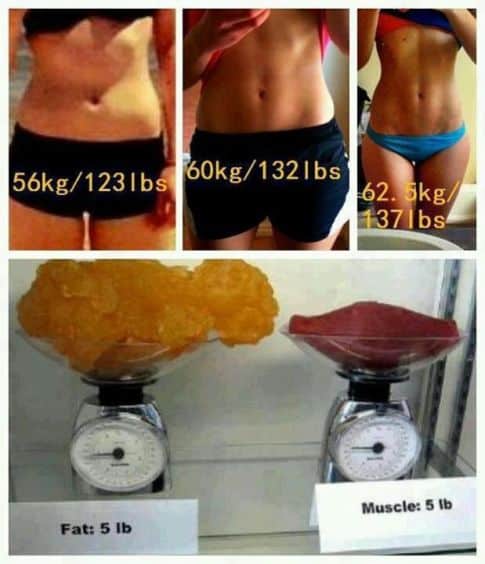
Take The 24 Fit Challenge






